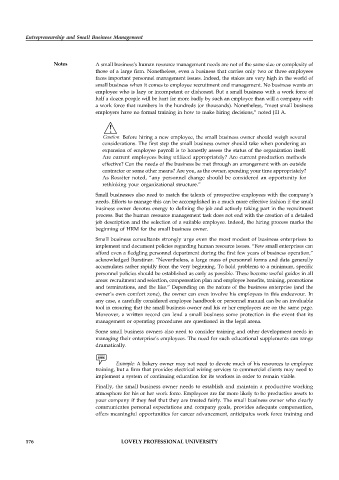Page 181 - DMGT310_ENTREPRENEURSHIP_AND_SMALL_BUSINESS_MANAGEMENT
P. 181
Entrepreneurship and Small Business Management
Notes A small business’s human resource management needs are not of the same size or complexity of
those of a large firm. Nonetheless, even a business that carries only two or three employees
faces important personnel management issues. Indeed, the stakes are very high in the world of
small business when it comes to employee recruitment and management. No business wants an
employee who is lazy or incompetent or dishonest. But a small business with a work force of
half a dozen people will be hurt far more badly by such an employee than will a company with
a work force that numbers in the hundreds (or thousands). Nonetheless, “most small business
employers have no formal training in how to make hiring decisions,” noted Jill A.
!
Caution Before hiring a new employee, the small business owner should weigh several
considerations. The first step the small business owner should take when pondering an
expansion of employee payroll is to honestly assess the status of the organization itself.
Are current employees being utilized appropriately? Are current production methods
effective? Can the needs of the business be met through an arrangement with an outside
contractor or some other means? Are you, as the owner, spending your time appropriately?
As Rossiter noted, “any personnel change should be considered an opportunity for
rethinking your organizational structure.”
Small businesses also need to match the talents of prospective employees with the company’s
needs. Efforts to manage this can be accomplished in a much more effective fashion if the small
business owner devotes energy to defining the job and actively taking part in the recruitment
process. But the human resource management task does not end with the creation of a detailed
job description and the selection of a suitable employee. Indeed, the hiring process marks the
beginning of HRM for the small business owner.
Small business consultants strongly urge even the most modest of business enterprises to
implement and document policies regarding human resource issues. “Few small enterprises can
afford even a fledgling personnel department during the first few years of business operation,”
acknowledged Burstiner. “Nevertheless, a large mass of personnel forms and data generally
accumulates rather rapidly from the very beginning. To hold problems to a minimum, specific
personnel policies should be established as early as possible. These become useful guides in all
areas: recruitment and selection, compensation plan and employee benefits, training, promotions
and terminations, and the like.” Depending on the nature of the business enterprise (and the
owner’s own comfort zone), the owner can even involve his employees in this endeavour. In
any case, a carefully considered employee handbook or personnel manual can be an invaluable
tool in ensuring that the small business owner and his or her employees are on the same page.
Moreover, a written record can lend a small business some protection in the event that its
management or operating procedures are questioned in the legal arena.
Some small business owners also need to consider training and other development needs in
managing their enterprise’s employees. The need for such educational supplements can range
dramatically.
Example: A bakery owner may not need to devote much of his resources to employee
training, but a firm that provides electrical wiring services to commercial clients may need to
implement a system of continuing education for its workers in order to remain viable.
Finally, the small business owner needs to establish and maintain a productive working
atmosphere for his or her work force. Employees are far more likely to be productive assets to
your company if they feel that they are treated fairly. The small business owner who clearly
communicates personal expectations and company goals, provides adequate compensation,
offers meaningful opportunities for career advancement, anticipates work force training and
176 LOVELY PROFESSIONAL UNIVERSITY

